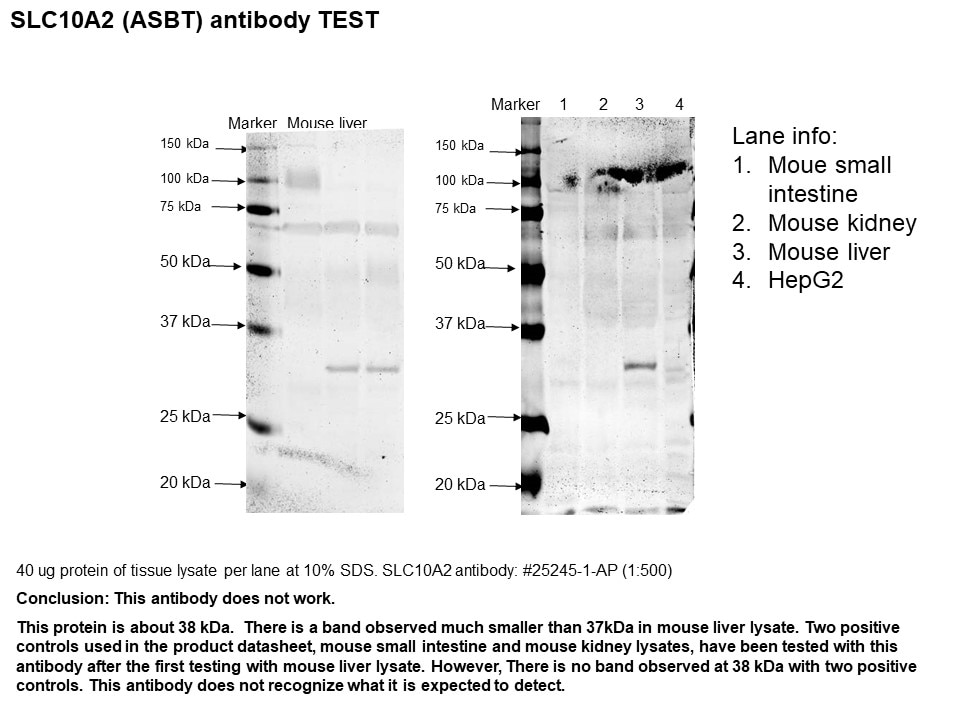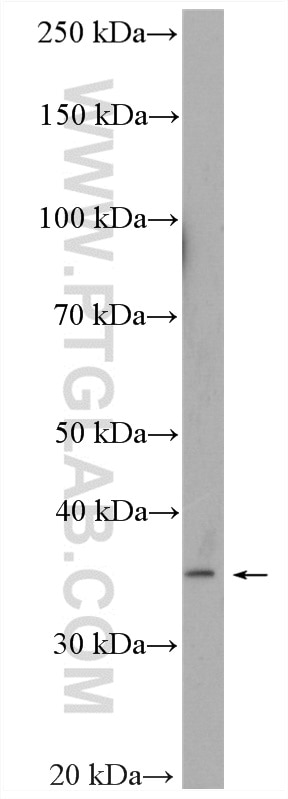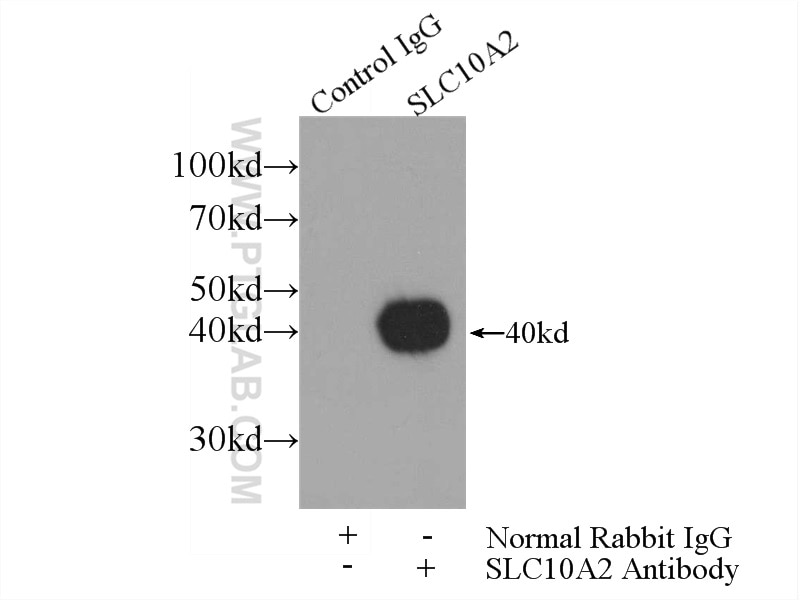Anticorps Polyclonal de lapin anti-SLC10A2/ASBT
SLC10A2/ASBT Polyclonal Antibody for WB, IP, ELISA
Hôte / Isotype
Lapin / IgG
Réactivité testée
Humain, souris et plus (1)
Applications
WB, IHC, IF, IP, ELISA
Conjugaison
Non conjugué
N° de cat : 25245-1-AP
Synonymes
Galerie de données de validation
Applications testées
| Résultats positifs en WB | tissu d'intestin grêle de souris, |
| Résultats positifs en IP | tissu rénal de souris |
Dilution recommandée
| Application | Dilution |
|---|---|
| Western Blot (WB) | WB : 1:200-1:1000 |
| Immunoprécipitation (IP) | IP : 0.5-4.0 ug for 1.0-3.0 mg of total protein lysate |
| It is recommended that this reagent should be titrated in each testing system to obtain optimal results. | |
| Sample-dependent, check data in validation data gallery | |
Applications publiées
| WB | See 18 publications below |
| IHC | See 2 publications below |
| IF | See 1 publications below |
Informations sur le produit
25245-1-AP cible SLC10A2/ASBT dans les applications de WB, IHC, IF, IP, ELISA et montre une réactivité avec des échantillons Humain, souris
| Réactivité | Humain, souris |
| Réactivité citée | Humain, souris, Hamster |
| Hôte / Isotype | Lapin / IgG |
| Clonalité | Polyclonal |
| Type | Anticorps |
| Immunogène | SLC10A2/ASBT Protéine recombinante Ag18808 |
| Nom complet | solute carrier family 10 (sodium/bile acid cotransporter family), member 2 |
| Masse moléculaire calculée | 348 aa, 38 kDa |
| Poids moléculaire observé | 38-40 kDa |
| Numéro d’acquisition GenBank | BC130523 |
| Symbole du gène | ASBT |
| Identification du gène (NCBI) | 6555 |
| Conjugaison | Non conjugué |
| Forme | Liquide |
| Méthode de purification | Purification par affinité contre l'antigène |
| Tampon de stockage | PBS with 0.02% sodium azide and 50% glycerol |
| Conditions de stockage | Stocker à -20°C. Stable pendant un an après l'expédition. L'aliquotage n'est pas nécessaire pour le stockage à -20oC Les 20ul contiennent 0,1% de BSA. |
Informations générales
SLC10A2 also known as ASBT, ISBT, and NTCP2, is a sodium/bile acid cotransporter that is primarily responsible for the uptake of bile acids by apical cells in the distal ileum(PMID: 8661017). Mutations in SLC10A2 cause primary bile acid malabsorption (PBAM) and may be associated with other diseases of the liver and intestines, such as familial hypertriglyceridemia (FHTG)(PMID: 9109432).
Protocole
| Product Specific Protocols | |
|---|---|
| WB protocol for SLC10A2/ASBT antibody 25245-1-AP | Download protocol |
| IP protocol for SLC10A2/ASBT antibody 25245-1-AP | Download protocol |
| Standard Protocols | |
|---|---|
| Click here to view our Standard Protocols |
Publications
| Species | Application | Title |
|---|---|---|
Gastroenterology Solute Carrier Organic Anion Transporter Family Member 3A1 Is a Bile Acid Efflux Transporter in Cholestasis. | ||
Cell Host Microbe Veillonella intestinal colonization promotes C. difficile infection in Crohn's disease | ||
Nat Commun Hypothalamic SLC7A14 accounts for aging-reduced lipolysis in white adipose tissue of male mice | ||
Pharmacol Res Geniposide reduces cholesterol accumulation and increases its excretion by regulating the FXR-mediated liver-gut crosstalk of bile acids. | ||
Mol Nutr Food Res The Effect of Coenzyme Q10 Supplementation on Bile Acid Metabolism: Insights from Network Pharmacology, Molecular Docking, and Experimental Validation | ||
J Agric Food Chem Novel Metabolic Regulation of Bile Acid Responses to Low Cholesterol in Whole-Grain-Diet-Fed Mice. |
Avis
The reviews below have been submitted by verified Proteintech customers who received an incentive for providing their feedback.
FH Hua (Verified Customer) (12-01-2020) | It does not work as expected.
 |



